
LITERARY TARANTO
These places have been described and recounted by men and women who have come and gone through history. Poets, writers, geographers and storytellers. Through their words we can make a voyage of discovery that takes us back in time and space.
Ancient literature
Leonidas of Tarentum (c. 320 - 260 BC) and nostalgia
The poet Leonidas lived in Taranto until the city was conquered by the Romans (272-270 BC).
When the city was about to surrender, Leonidas was among the few inhabitants who were able to escape: a fact that he initially interpreted as a blessing, having avoided slavery, but that soon turned out to be a bitter illusion, since from then until his death, he lived far from his homeland, in search of patrons, living ‘a life that is not life’ as he wrote in a famous epigram.
“Far from Taranto, my land, I lie and this seems to me more bitter than death”.
Publius Virgil Maron (70 BC-19 BC) and the sense of fulfillment of the land
“I do indeed remember having met, near the towers of Tarentum, where the shady Galeso bathes the blond fields, an old man from Corico who owned only a few acres of land […] He, however, planting among the brambles here and there a few herbs and white lilies and verbenas and edible poppies, in his heart felt as rich as a king”.
Virgilio, Georgiche, IV, 125
Quintus Horatius Flaccus (65 BC-8 BC) and the Odes
«To the sweet currents of the Galeso, where flocks of fine wool descend, among the fields where Phalanthos of Laconia founded his kingdom. That corner of the earth is the one that, more than any other, is pleasant to me, that produces good honey […] there the sky offers long spring and warm winter».
Horace, Odes, II, 6


Galeso river flowing into the Mar Piccolo
Gaius Petronius Arbiter (27-66 AD) observes Tarantine society
The Roman writer and politician Petronius, in his masterpiece Satyricon, written around the year 54, has among his main characters the Tarentine Lica.
Lica is a maritime entrepreneur who trades along the coasts of Italy, 'a good man, who, besides being the owner of this ship and some farms, has a trading company and carries a cargo to sell'.
From this account, the role of the port of Taranto in the years of Emperor Nero can be deduced.

Petronius (Gaius Petronius Arbiter) in an eighteenth-century print (source: Wikimedia Commons)
Taranto in the Medieval Period
The geographer Al-Idrisi (12th century), in his ``Book of King Roger``, describes Taranto as follows
«Taranto is a large city, of ancient construction and remote origin, with beautiful buildings and sumptuous palaces. It is frequented by merchants and travellers. There, ships are loaded and caravans arrive, being furnished with an abundance of wares and riches. The city has a harbour in the open sea from the west and from the east by the north wind it has a small sea that measures twelve miles around, going from the bridge to the city side. This bridge is between the open sea and the small sea; it is three hundred cubits long from the gate of Taranto that looks north to the mainland, and it is fifteen wide. […]The city is surrounded by the open sea and the small sea on all sides, with the exception of the one facing north.»

Map of Southern Italy by Al-Idrisi, 1154<br /> Al-Idrisi drew southern Italy with the south at the top and the north at the bottom, so we see it depicted upside down.(source www.andriarte.it)<br />
Testimonies from the Renaissance to the Modern Age
The traveller Johann Hermann von Riedesel (1740 – 1785)
In 1766, the German Baron Johann Hermann von RiedeseI (1740-1785) visited the ancient monuments in Taranto in the company of Cataldo Antonio Atenisio Carducci (1733-1775), an expert on ancient artefacts, and wrote :
“He showed me outside the city, in a field of grain, a round hole turned upwards, where there are two ducts, one to carry water and the other to make it flow; he believes that this hole was used for the preparation of the colour purple, of which the imprint can still be seen in the walls: moreover, he has observed that very close to there, on the side of the small sea, which was really the ancient port, there is a hill entirely formed of ‘murici’, a shell from which it is known that the ancients drew purple.”

Portrait of Johann Hermann von Riedesel from 1779-1782 (source Wikimedia Commons, Universitätsbibliothek Heidelberg)
Taranto through contemporary eyes
The verses of Gabriele D'Annunzio (1863-1938)
In January 1912, the “Corriere della sera” published Gabriele D’Annunzio’s Canzone dei Dardanelli, which begins by citing Taranto.
“Taranto, only for anchors and moorings
secure in the well-defended mirror
of such fresh purple do you blush?
To what between San Cataldo and your old
wall, that knows Byzantium and Aragon
that knows Swabia and Anjou, do you bend your ear?
Neither flashes on the Mar Grande, nor thunders,
But on the iron-clad hinge your bridge
turns and the iron of your canal resonates.
Thus pass the beautiful ships ready
to enter the safe harbour,
turn the stern to the Ionian horizon.”
Aldo Palazzeschi (1885 – 1974) and the hand of the centuries
“Taranto Vecchia [“Old Taranto”] leaves us with – is one of those creations which surpass human artistic creation and that only that artist we call ‘time’ can realise”
(this is the thought that Palazzeschi)
The emotions of Guido Piovene (1907-1974)
Travellers are often enraptured by the beauty of the place. Guido Piovene wrote in 1967:
«T’Taranto lives among reflections, in a translucent atmosphere ideal for extraordinary displays of light. I witnessed a splendid sunset, with the sun turning red and setting rapidly, like an island of fire sinking into the waters».
Pier Paolo Pasolini (1922-1975)
«Taranto is a perfect city. Living there is like living inside a shell, an open oyster. Here, new Taranto, there, crowded, old Taranto, around the two seas and the seafront promenades.»
This is how Pier Paolo Pasolini described it in July 1959, during a trip he made along the coastal road from Ventimiglia to Trieste to chronicle Italians’ summer. Exactly one year later, on 9 July 1960, the first stone was laid for the construction of Italsider, Italy’s largest steelworks. This section offers visitors a collection of written texts, images and films describing this place and its transformation.
Alda Merini
«I will never see beautiful Taranto/ I will never see the birch trees/ nor the marine forest;/ the wave is petrified/ and the octopuses pulsate in my eyes./ You came, my love,/ in a river inlet,/ you have stopped my course/ and I will never see blue Taranto,/ and the Ionian Sea will sound my funeral rites».

